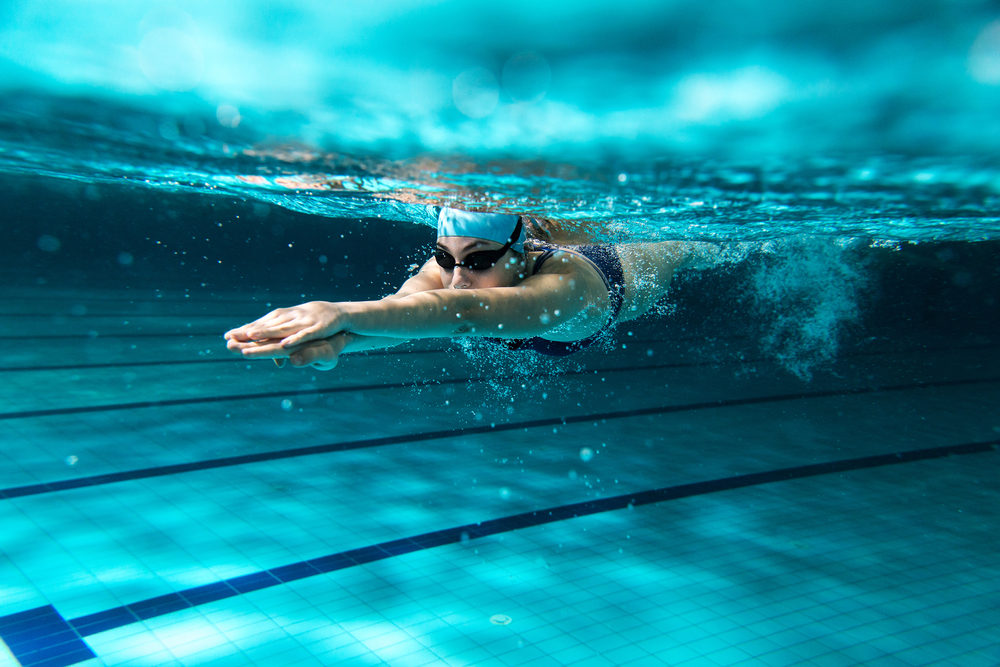Swimmers often suffer from overuse injuries in the knees and shoulders. Here are some simple steps they can take to remain in top form when hitting the pool.
Swimming is generally a gentle, low-impact exercise, but like any sport, there are risks for joint pain and injury. Competitive swimming places particular stress on the shoulders and knees, and if athletes don’t prepare properly, they can suffer long-term damage to the joints.
Swimmers looking to avoid debilitating injuries should take care to warm up their muscles, protect their joints, and give their bodies time to rest between workouts or competitions. This guide explores three of the most common swimming injuries, their causes, and the best ways to prevent them.
SHOULDER IMPINGEMENT (SWIMMER’S SHOULDER)
Swimmer’s shoulder refers to shoulder pain resulting from a variety of conditions, including shoulder impingement. This injury occurs when the tendons attached to the rotator cuff muscles are caught between the acromion and humerus bones, usually as the result of bone spurs. This causes the shoulder tendons to become irritated or inflamed.
The frequent rotation of the shoulder joint in swimming means that athletes are especially prone to shoulder impingement. The repetitive motion of the freestyle stroke, for example, can lead to fatigue in the rotator cuff muscles and cause the tendons and other tissues to rub against one another. The resulting irritation causes a heavy pain in the arm or shoulder as well as a general sense of weakness.
To prevent shoulder impingement, it’s important to strengthen the rotator cuff muscles through yoga or other stretching exercises. By building up power in the shoulder, back, and chest, these muscles and tendons become more resistant to injury. Swimmers can also adjust their technique by retracting their shoulders during overhand strokes instead of hyperextending them. By drawing down the shoulder blades and pinching them together, swimmers can better support their arms and develop a more consistent stroke.
BICEPS TENDONITIS
Biceps tendonitis is another common injury that can affect a swimmer’s shoulder. This condition is marked by inflammation in one of the tendons that connects the biceps muscles to the shoulder. Tendonitis usually affects the upper biceps tendon, causing inflammation and swelling. This injury may also be accompanied by other conditions like rotator cuff tears, labral tears, shoulder impingement, and biceps subluxation.
Like other types of tendonitis, biceps tendonitis is often the result of overuse. The repetitive overhead motions of swimming can irritate the tendons in the shoulder, leading to pain, weakness, and achiness. This pain often radiates down the upper arm, worsening when objects are lifted overhead. There may be other symptoms present as well if biceps tendonitis is accompanied by a SLAP tear, impingement, or arthritis.
Swimmers can avoid biceps tendonitis by incorporating different types of resistance training into their regimen. When performed together, pushing exercises like push-ups or bench presses and pulling exercises like pull-ups or rowing help build balanced shoulder strength. A strong and flexible upper body can thus relieve pressure on connective tissues like tendons and prevent painful injuries.
MCL TEAR (BREATSTROKER’S KNEE)
When it comes to the knees, swimmers are often prone to injuries affecting the medial collateral ligament (MCL). This ligament helps stabilize the knee and allows it to rotate. MCL tears can be classified as grades 1, 2, or 3, depending on severity. A grade 1 classification indicates that the ligament is stretched but not ruptured, while grade 5 describes a completely torn ligament.
Breaststrokers are especially at risk for MCL tears given how they position their legs while in motion. By facing their feet outward while doing the breaststroke, swimmers may irritate the ligaments in the knee and cause pain and inflammation. Other symptoms of the condition include stiffness, tenderness, instability, and a limited range of motion.
To prevent breaststroker’s knee, swimmers should be sure to warm up properly before each workout. Stretching that focuses on increasing mobility in the hip and groin muscles tends to be most effective in addressing the root of knee pain. Swimmers should also work on building up their strength out of the water with leg exercises like lunges, good mornings (hip hinge stretches), eccentric bilateral squats, and hip bridges.
SEEKING TREATMENT
Most importantly, if you’re suffering from knee or shoulder pain, don’t ignore it. Take time to rest and listen to what your body is telling you. If simple measures like icing and anti-inflammatories don’t provide adequate relief, schedule an appointment with an orthopedic specialist as soon as possible.
The surgeons and physical therapists at New York Bone & Joint Specialists are experts in treating sports injuries, including common injuries that affect swimmers. They can help diagnose your condition and develop a personalized treatment plan that will have you back in the pool as soon as possible.




